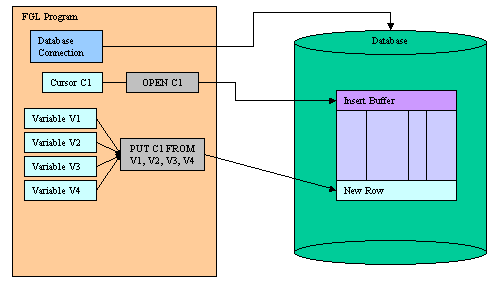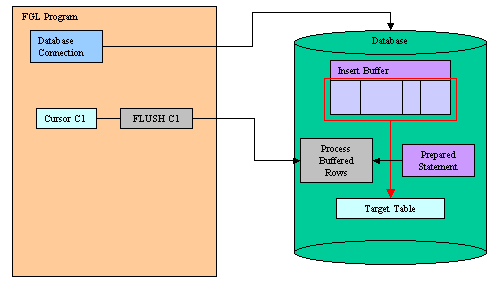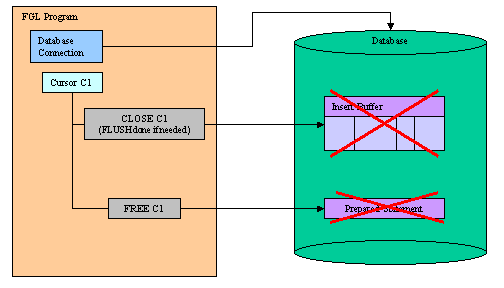
Summary:
See also: Transactions, Static SQL, Dynamic SQL, Result Sets, SQL Errors.
An Insert Cursor is a database cursor declared with a restricted form of the INSERT statement, designed to perform buffered row insertion in database tables.
The insert cursor simply inserts rows of data; it cannot be used to fetch data. When an insert cursor is opened, a buffer is created in memory to hold a block of rows. The buffer receives rows of data as the program executes PUT statements. The rows are written to disk only when the buffer is full. You can use the CLOSE, FLUSH, or COMMIT WORK statement to flush the buffer when it is less than full. You must close an insert cursor to insert any buffered rows into the database before the program ends. You can lose data if you do not close the cursor properly.
When the database server supports buffered inserts, an insert cursor increases processing efficiency (compared with embedding the INSERT statement directly). This process reduces communication between the program and the database server and also increases the speed of the insertions.
Before using the insert cursor, you must declare it with the DECLARE instruction using an INSERT statement:

Once declared, you can open the insert cursor with the OPEN instruction. This instruction prepares the insert buffer. When the insert cursor is opened, you can add rows to the insert buffer with the PUT statement:

Rows are automatically added to the database table when the insert buffer is full. To force row insertion in the table, you can use the FLUSH instruction:

Finally, when all rows are added, you can CLOSE the cursor and if you no longer need it, you can de-allocate resources with the FREE instruction:

By default, insert cursors must be opened inside a transaction block, with BEGIN WORK and COMMIT WORK, and they are automatically closed at the end of the transaction. If needed, you can declare insert cursors with the WITH HOLD clause, to allow uninterrupted row insertion across multiple transactions. See example 3 at the bottom of this page.
Declares a new insert cursor in the current database session.
DECLARE cid CURSOR [WITH
HOLD] FOR { insert-statement
| sid }
Use the DECLARE instruction with an INSERT instruction to define a new insert cursor.
The INSERT statement is parsed, validated and the execution plan is created.DECLARE must precede any other statement that refers to the cursor during program execution.
The scope of reference of the cid cursor identifier is local to the module where it is declared.
When declaring a cursor with a static insert-statement, the statement can include a list of variables in the VALUES clause. These variables are automatically read by the PUT statement; you do not have to provide the list of variables in that statement. See Example 1 for more details.
When declaring a cursor with a prepared sid statement, the statement can include (?) question mark placeholders for SQL parameters. In this case you must provide a list of variables in the FROM clause of the PUT statement. See Example 2 for more details.
Use the WITH HOLD option to declare cursors that have uninterrupted inserts across multiple transactions.
Resources allocated by the DECLARE can be released later by the FREE instruction.
The number of declared cursors in a single program is limited by the database server and the available memory. Make sure that you free the resources when you no longer need the declared insert cursor.
The identifier of a cursor that was declared in one module cannot be referenced from another module.
Opens an insert cursor in the current database session.
OPEN cid
The OPEN statement initializes the insert cursor, to accept rows with the PUT statement.
When used with an insert cursor, the OPEN instruction cannot include a USING clause.A subsequent OPEN statement closes the cursor and then reopens it.
If the insert cursor was not declared WITH HOLD option, the OPEN instruction generates an SQL error if there is no current transaction started.
If you release cursor resources with a FREE instruction, you cannot use the cursor unless you declare the cursor again.Adds a new row to the insert cursor buffer in the current database session.
PUT cid FROM paramvar [,...]
If the insert cursor was not declared WITH HOLD option, the PUT instruction generates an SQL error if there is no current transaction started.
If the insert buffer has no room for the new row when the statement executes, the buffered rows are written to the database in a block, and the buffer is emptied. As a result, some PUT statement executions cause rows to be written to the database, and some do not.Flushes the buffer of an insert cursor in the current database session.
FLUSH cid
When flushing an insert cursor, all buffered rows are inserted into the target table and the the insert buffer is cleared.
The insert buffer may be automatically flushed by the runtime system if there no room when a new row is added with the PUT instruction.
Closes an insert cursor in the current database session.
CLOSE cid
If rows are present in the insert buffer, they are inserted into the target table.
Closing the insert cursor releases the resources allocated for the insert buffer on the database server.After using the CLOSE instruction, you must re-open the cursor with OPEN before adding new rows with PUT / FLUSH.
Releases resources allocated for an insert cursor in the current database session.
FREE cid
The cursor should be explicitly closed before it is freed.
If you release cursor resources with this instruction, you cannot use the cursor unless you declare the cursor again.
01MAIN02DEFINE i INTEGER03DEFINE rec RECORD04key INTEGER,05name CHAR(30)06END RECORD07DATABASE stock08DECLARE ic CURSOR FOR09INSERT INTO item VALUES (rec.*)10BEGIN WORK11OPEN ic12FOR i=1 TO 10013LET rec.key = i14LET rec.name = "Item #" || i15PUT ic16IF i MOD 50 = 0 THEN17FLUSH ic18END IF19END FOR20CLOSE ic21COMMIT WORK22FREE ic23END MAIN
01MAIN02DEFINE i INTEGER03DEFINE rec RECORD04key INTEGER,05name CHAR(30)06END RECORD07DATABASE stock08PREPARE is FROM "INSERT INTO item VALUES (?,?)"09DECLARE ic CURSOR FOR is10BEGIN WORK11OPEN ic12FOR i=1 TO 10013LET rec.key = i14LET rec.name = "Item #" || i15PUT ic FROM rec.*16IF i MOD 50 = 0 THEN17FLUSH ic18END IF19END FOR20CLOSE ic21COMMIT WORK22FREE ic23FREE is24END MAIN
01MAIN02DEFINE name CHAR(30)03DATABASE stock04DECLARE ic CURSOR WITH HOLD FOR05INSERT INTO item VALUES (1,name)06OPEN ic07LET name = "Item 1"08PUT ic09BEGIN WORK10UPDATE refs SET name="xyz" WHERE key=12311COMMIT WORK12PUT ic13PUT ic14FLUSH ic15CLOSE ic16FREE ic17END MAIN